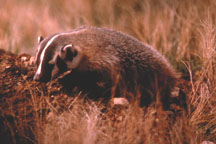|
Habitat Atlas for Wildlife at Risk
Badger
Taxidea taxus

Badger
|
- Weight: 6-14 kg; length: 65-90 cm.
- Badgers are one of the largest members of the
weasel family.
- Stout, shaggy animals with distinctive black and
white facial markings and a short tail.
- Black fur around the eyes and on the side of the
snout, and a triangular black patch, surrounded by
white fur
on the side of the face; grey to brown body fur
with lighter undersides.
- Maximum lifespan is approximately 14 years.
Habitat map not available.
Status:
British Columbia Red List
Special Significance
The Badger is at risk in British Columbia because the amount of suitable
habitat is small and has been adversely affected by human activity.
Key areas of low elevation grasslands and open pine or fir forests
have been lost. The small British Columbia population is vulnerable
to regional and provincial extirpation. This burrowing mammal may
play an important role controlling rodents that cause pasture or cropland
damage. The continued survival of Badger populations in British Columbia
requires establishment of protected areas, responsible stewardship
of ranges used for cattle grazing, appropriate forest management practices,
a reduction in the use of rodenticides and an increased understanding
of this interesting animal.
Distribution
- In British Columbia, Badgers occur in the Okanagan and Similkameen
Valleys, Thompson River, Nicola Valley, and East Kootenay areas; a
few Badgers have been noted in the South Cariboo, West Kootenay and
eastern Chilcotin. Elevational range within British Columbia is 400
to 1500 metres, and occasionally up to 2400 metres.
Habitat
- Badgers occur primarily in deep-soiled grassland, shrub-steppe,
and open stands of ponderosa pine or Douglas-fir.
- Cultivated lands and rural roadsides will also be inhabited
by Badgers if prey is available.
Reproduction
- Mating occurs in July or August and delayed implantation
results in young being born around April.
- Litters vary from 1 to 4 kits (average 2); only one
litter is produced per year.
- Young Badgers nurse for 5-6 weeks; young disperse at
10 -12 weeks of age.
Food Habits
- Diet consists of mainly burrowing mammals such as ground
squirrels, pocket gophers and marmots, but also
includes animals that take refuge in burrows including snakes, rabbits
and chipmunks.
- These opportunistic mammals will also consume mice,
muskrats, birds, bird eggs, insects, carrion and
plant food.
- Badgers rely on a highly developed sense of smell to
locate prey.
Interesting Facts
- Badgers have dens which usually have several tunnels
and separate chambers.
- Black patches or 'badges' on each cheek give the Badger
its name.
- Abandoned burrows provide important nesting sites for
other wildlife such as Burrowing Owls.
Threats
- Fire suppression causes forest encroachment on
grasslands.
- Loss and alteration of low elevation grasslands
and open coniferous forests for development.
- Killed by motor vehicles, especially dispersing
young.
- Illegal or accidental trapping; ground-dwelling
animals are often shot as pests.
- Reduced food supply and secondary poisoning from
rodenticides.
Management Considerations
- Maintain large tracts of key habitat, particularly
open grassy areas with soils suitable for
excavating burrows.
- Employ grazing management practices that promote
the growth of healthy native grassland communities.
- Carefully monitor the use of rodenticides.
- Support prescribed burning programs.
- Encourage landowners to adopt a more sympathetic
attitude towards Badgers and ground squirrels.
- Report any observations of shooting, trapping,
or harassment.
|
References
1. Blood, D.A. 1995. Wildlife at risk in British Columbia brochure:
Badger. Ministry of Water, Land and Air Protection, Lands and Parks,
Victoria, British Columbia.
2. Rahme, A.H., A.S Harestad and F.L. Bunnell. 1995.
Status of the Badger in British Columbia. Wildlife Working Report
No. WR-72. Ministry of Water, Land and Air Protection, Lands and Parks,
Victoria, British Columbia.
|